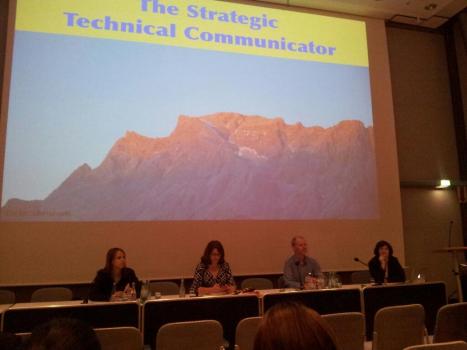tekom, the world’s largest tech comm conference, ended today after three days with more than 220 presentations, workshops and tutorials in German and English. (More detailed numbers and much, much more conference blogging over at Sarah Maddox’ blog.) Here are 12 lessons that I learned and 3 ways how I think tekom is unique and different from other conferences I’ve been to, such as TCUK, the STC Summit or WritersUA.
What I learned
5 lessons about tech comm:
- “Cheap documentation is expensive!” – From Sarah O’Keefe’s session on Transforming Technical Content into a Business Asset.
- “Poor design costs!” – From Leah Guren’s Advanced Visual Editing.
- Reuse or conditionalize complete sentences, no less. Else it becomes virtually impossible to translate in DITA or otherwise. – From Marijana Prusina’s tutorial Around the World with DITA (in German).
- Cross-language documentation works. German and English are related so closely, you can successfully create German documentation for English interfaces. You will need to pay some attention to grammar, spelling and anglicisms, though. – From Marc Achtelig’s Do you speak Deutsch? (in German).
- Cloud-based terminology is coming. The European Union funds a cloud-based Terminology as a Service project. – From Klaus Schmitz’ Terminological Information and Services for Language Workers (in German).
And 7 lessons about tech comm conferences:
- Have business cards handy. Even “after-hours” over beer, they might just get you a cool free t-shirt by Atlassian that says “Don’t drink and write.”
- Maintain a network. A good network of fellow tech comm’ers can help you in more situations than I imagined. – From the Strategic Technical Communicator panel. And from lining up a few more speaking opportunities by tapping my, uhm: network… 🙂
- Have worthwhile content. High-concept talks will fail if the first half is trends and statistics which any listener will know who’s keeping up with industry news and the second half is about the great things your company does. – From a session I marked down on the evaluation sheet.
- Unusual topics work. Presentations, such as how meaning works in tech comm, can succeed if you have a well-told, well-sourced story, even if the research is a bit farther afield, for example, from semiotics or psychology.
- Know your audience. The rift between academia and tech comm’ers will persist if research feels like institutions and budgets trying to justify themselves. I think presentations of academic research will be more successful if they appeal to a common interest in how and why stuff works. German academic speakers, please know your audience and front-load the cool benefits you can bring, not your definitions and methodology.
- Know time. Speakers, please practice and if necessary cut down your talk: Running late and then skipping over the last slides is doubly annoying. Unless you’ve been added to the program late, you’ve had plenty of advance notice!
- Have some integrity. It’s fine to talk about yourself if you have a good story, but please don’t undermine your session title and audience expectations. “Be more like me!” is not a widely applicable answer to “How to do X?”
How tekom is unique
- Size. tekom is first and foremost uniquely large, it is huuuuge! 2400 registered attendants attending 15 concurrent streams of sessions takes a convention center, not a conference hotel as I know it from other tech comm conferences. Because it is so huge, you need more planning to ensure you’re hitting the best sessions.
- Global and bilingual. Even though it is predominantly a German conference, it is the most successfully international, multi-lingual conference I know. A quarter of all presentations, workshops and tutorials are in English. My personal impression is that attendees come from more countries than to any conference.
- Variety in content. Because of the huge number of sessions, tekom affords more variety in sessions than I’ve seen elsewhere. Streams are dedicated to the usual suspects, such as content strategy, localization, mobile documentation, user assistance. Add to that more unusual, but valuable streams, such as higher education and academia, visual communication, personnel and cost management.
Thanks to everyone who helped to make this year’s conference a success, especially to tekom’s dedicated conference crew!
-Oh, and as it turns out: You’ve just reached the end of my 200th blog post… 🙂 Thanks for reading, thank you for your support!
Filed under: conferences | Tagged: tcworld12, tekom12 | 3 Comments »




